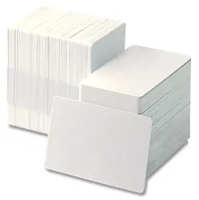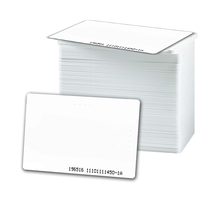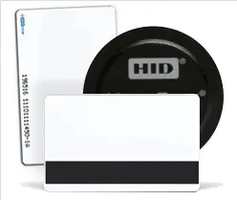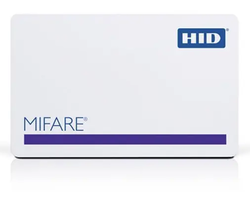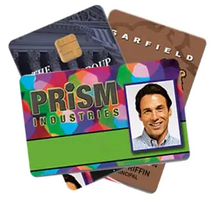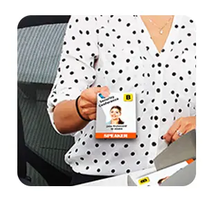ID Cards
We carry a large inventory of ID Cards from blank PVC Cards to technology cards.
- Large selection of PVC Cards in a variety of sizes, thicknesses and colors.
- Range of proximity cards that we can program for you for access control purposes.
- ID Card service bureau to order pre-printed ID Cards and badges.
- Free shipping on all orders over $100
WHAT TYPES OF ID CARDS DO YOU OFFER?
We offer 4 different types of ID cards: PVC cards, proximity cards, iCLASS® cards and pre-printed cards.
- PVC cards: commonly referred to as plastic cards, PVC cards come in a variety of sizes, thicknesses and colors. The most standard size is called CR80 - which is the size of your credit card (3.375" x 2.125") – but we also carry CR79 cards (3.303" x 2.051") that are a bit smaller and feature an adhesive back. Thicknesses vary from 10 to 30mil. As a reference, your credit card is a 30mil card. PVC cards can also include additional features such as magnetic stripes for multifunctional badges.
If you want to create unique ID cards, browse our selection of color PVC cards. - Proximity cards: “Prox” cards have an embedded antenna that stores the cardholder data. This data can be read when the proximity card is passed within range of a reader. Mainly used for access control applications, proximity cards are also chosen in environments where crowd control is a factor. Prox cards can be programmed online or call us to talk to an ID expert.
- iCLASS® cards: iCLASS® cards combine contactless smart technology with a contact chip and/or a magnetic stripe. iCLASS® cards provide 13.56 MHz contactless smart card technology and allow users to add a barcode, magnetic stripe, photo ID, graphics, or anti-counterfeiting features. HID’s iCLASS® cards can be used for diverse applications such as access control, biometrics, cashless vending, public transportation, airline ticketing and customer loyalty programs.
- Pre-printed cards: this option is ideal for membership cards, loyalty cards, or other ID cards where only a name, ID number or barcode might be added onsite. Let us print professional cards and if needed, personalize them on the spot in seconds. You will get stunning results that will definitely impress your customers.
HOW DO I CHOOSE THE RIGHT ID CARDS?
Your card printer and card application will determine which ID cards are right for you. Here are a few tips when choosing ID cards:
- Card thickness: ID card printers will only accept specific card thicknesses. Most printers are built to print 30mil cards (thickness of a credit card) so if you need to personalize thinner cards (10-20mil), check the specs of your printer.
- Card size: most ID card printers print CR80 cards (3.375" x 2.125"), CR80 being the standard card size. However, if you need to print cards of other sizes such as CR79 (3.303" x 2.051"), note that only a few card printers will allow it.
- Card material: the most common type of plastic card is 100% PVC. However, it is recommended to use composite PVC/PET cards for retransfer and laminating printers. Composite cards are 60% PVC and 40% PET and are more durable than PVC cards. They are also heat resistant and won’t bend under high temperatures. Composite cards can be used with any card printer.
- Technology cards: if your printer is equipped with a magnetic encoder and you need to store data into a magnetic stripe, you will have the choice between high coercivity (HiCo) and low coercivity (LoCo) cards. HiCo cards are very resistant, harder to erase and built to handle frequent usage. Choose HiCo cards for access control or time and attendance applications. Less expensive but also less resistant, low coercivity cards work best with short-term applications such as hotel room keys or event passes.
For advanced access control systems, proximity cards are a popular choice. Proximity cards are read-only devices: that is why the encoding is typically handled by manufacturers before shipping.
CAN I STORE DATA ON MY COMPANY’S VISITOR BADGES?
Many visitor ID programs are simple and don’t require sophisticated security features. In these cases, self-expiring paper labels applied to PVC card stock are often sufficient to meet visitor-program requirements. But in larger organizations or high-security businesses, visitor management is a part of regulatory compliance and risk mitigation. These enterprises’ visitor ID management programs must ensure visitors are fully identified and that their visitor badge contain all essential information about the individual and permit the individual access to secure areas as appropriate. Visitor data can be printed visually on the card face or stored digitally in the card’s magnetic stripe embedded chip.
For security and privacy reasons, many organizations encode visitor information to their cards to keep it confidential and secure. In these circumstances, contact smart cards with an embedded integrated circuit chip, or can store sensitive or valuable information about the visitor, which is then read as appropriate at various access points. Some smart cards have sophisticated microprocessor chips with built in state-of-the-art security features to protect the stored visitor information from unauthorized access. These smart cards are read by a reader. Contactless smart cards, proximity cards, and hybrid cards contain an embedded antenna for reading and writing information contained in the chip’s memory, and can be read by passing them near the reader.


